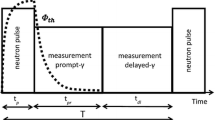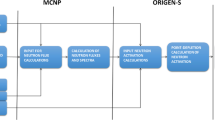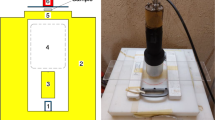Abstract
In order to determine nonradioactive substances in radioactive waste packages an innovative method based on prompt gamma neutron activation analysis was developed. The methodology was verified through the analysis of a 200 L steel drum homogeneously filled with concrete. The results obtained for the elemental composition of concrete are in good agreement with the expected values, the differences lying between −9 and +5 %. The limits of detection for the toxic elements cadmium and mercury are 4 and 145 mg/kg, respectively for an assay time of 2000s.
Similar content being viewed by others
Explore related subjects
Discover the latest articles, news and stories from top researchers in related subjects.Avoid common mistakes on your manuscript.
Introduction
The safe management and disposal of radioactive waste with negligible heat generation (low and intermediate level radioactive waste) requires knowledge of its inventory with regards to chemically toxic and nontoxic substances [1]. For the disposal of such radioactive waste in the repository Konrad (Germany) a description and declaration thresholds for nonradioactive substances were defined, usually as 1 and 5 % of the total waste package weight for new and old waste, respectively [2]. The terminology new waste refers to radioactive waste which has been conditioned according a qualified process after the entry into force of the Konrad plan approval decision [3]. To comply with these requirements and the waste acceptance criteria every waste package has to be characterized in its radiological and chemical composition. The waste producers have to indicate the substance and its mass in the material description of the waste packages if the mass fraction of the substance exceeds the description threshold. Substances which exceeds their declaration threshold are identified as hazardous and are taking into account for balancing the waste inventory. The amount of chemically toxic elements in the waste is limited in order to avoid pollution of underground water reserves.
This material characterization can be performed on the basis of existing documentation or, if the documentation is insufficient, on further analytical analysis. In a previous paper [4] related through the development of the analytical facility MEDINA (Multi Element Determination based on Instrumental Neutron Activation) we have shown that prompt gamma neutron activation analysis (PGNAA) using a pulsed 14 MeV neutron source is suitable to identify nondestructively toxic elements in 200 L radioactive waste drums.
In this work we report on the PGNAA of a 200 L steel drum filled with concrete, which often is employed as embedding material in waste conditioning. The method to assess the elemental composition of concrete including the determination of relevant parameters such as the gamma-ray detection efficiency, the thermal neutron flux and the epithermal to thermal neutron flux ratio is presented. The concentrations of the detected elements hydrogen, boron, aluminum, silicon, potassium calcium and titan are compared with the values obtained from the PGNAA of small samples (3–5 g) of the same concrete at the cold neutron beam of the Budapest Research Reactor [5]. As an example, detection limits for the toxic elements cadmium and mercury are also evaluated.
Basic considerations
The net peak area \( P_{{{\text{E}}\gamma }} \) of a prompt gamma ray with the isotope specific energy Eγ induced by thermal and epithermal neutron capture may be expressed by the following equation:
where m (g) is the mass of the element, M (g mol−1) the molar mass of the element, NA the Avogadro number, σEγ (cm2) the partial gamma-ray production cross section [6, 7], σ (cm2) the isotopic thermal neutron capture cross section [8], I (cm2) the isotopic resonance integral [8], Φth (cm−2 s−1) the average thermal neutron flux within the sample, R the epithermal to thermal neutron flux ratio, εEγ the gamma-ray detection efficiency and t (s) the counting time. The product \( \sigma_{{{\text{E}}\gamma }} \times \varPhi_{\text{th}} \times 0.44 \times {\text{R}} \) in (1) takes into account the 1/v characteristic of the absorption cross section in the epithermal region [9].
Measurements
The measurement was done with a 200 L steel drum filled with 76 cylindrical concrete bodies (4 layers with 19 bodies each) as shown in Fig. 1. The steel drum has a filling height of 83 cm, an internal diameter of 56 cm and a total weight of 53.2 kg. The iron content of the steel drum is 98.38 wt%. The total amount of concrete is 199.5 kg and due to the empty space between the bodies the apparent density of the concrete matrix is 1.02 g cm−3. The concrete drum is irradiated in the MEDINA facility with 14 MeV neutrons produced by a deuterium–tritium (D-T) neutron generator (GENIE16GT, EADS SODERN). The distance between the tritium-target of the neutron generator and the center of the drum is 55 cm. The neutron generator is operated in pulse mode with an acceleration voltage of 85 kV and an ion current of 40 μA leading to a neutron emission of about 8 × 107 n s−1. The length of the 14 MeV neutron pulses is set to 50 μs and the repetition period of the neutron pulses to 1 ms. As the repetition period of the neutron pulses is lower than the die-away time of thermal neutrons in concrete which is 2.23 ms [10] a constant average thermal and epithermal neutron flux is reached after few neutron pulses.
The detection of the gamma rays is achieved with a 104 % n-type HPGe-detector (CANBERRA) entirely shielded against thermal neutrons with 6LiF plates. The distance between the centre of the drum and the detector window is 105 cm so that the complete volume of the concrete drum is assayed. The processing of the detector signals for spectra acquisition is described in [4]. The gamma rays are measured between the neutron pulses over a counting time of 930 μs. The measurement was started 20 μs after the end of the neutron pulses to allow the slowing down of fast neutrons. The gamma-ray spectrum is recorded during 1860s in Zero Dead Time mode with the software Gamma Vision-32 (ORTEC) and analyzed with the spectroscopy software Gamma-W (Dr. Westmeier GmbH). The origin of the prompt and delayed gamma rays identified in the spectra of the concrete drum, the empty drum and the empty chamber are discussed in [4]. The spectrum of the empty drum recorded under the same irradiation and measurement conditions as for the drum filled with concrete is used for background correction of the hydrogen, boron, aluminum and titan gamma-ray count rates. As the Gamma-W software does not contain a procedure for analysis of Doppler-broadened photopeak [11], the 477-keV peak induced though the (n,α)-reaction on 10B is simply fitted as a multiplet including also the possible interfering 472-keV peak of 24mNa. The gamma-ray count rates for the elements of interest are given in Table 2 together with the required cross section data to determine the elemental concentrations by mean of relation (1).
Gamma-ray detection efficiency
The gamma-ray detection efficiency εEγ for the steel drum including top and bottom and for the concrete matrix is calculated numerically with an own developed algorithm [12, 13] based on the following formula:
where ε0Eγ is the detection efficiency of the considered gamma-ray energy for a point source at the distance d 0 = 105 cm from the detector surface, n the number of point sources distributed either in the concrete matrix or in the steel drum using cylindrical coordinates, di the distance of the ith point source from the detector surface, ρc = 1.02 g cm−3 and ρd = 7.84 g cm−3 the densities of the concrete matrix and the steel drum, respectively, μ/ρc and μ/ρd (cm2 g−1) the corresponding mass attenuation coefficients [14] at the considered gamma-ray energy and l i and k i (cm) the mean distances covered by the gamma ray of the ith point source in the concrete matrix and the steel drum, respectively to reach the centre of detector surface. Numerical simulations are performed for the half-volume of the concrete matrix and of the drum cylinder due to their symmetry with respect to the HPGe-detector. Simulations for the cover and bottom of the drum are carried out apart. The detection efficiency for the steel drum is obtained by summing the efficiencies of the different parts of the drum weighted by the corresponding weight fractions. The number of point sources distributed in the concrete matrix is 21.6 × 106 and in the steel drum 3.8 × 106.
The detection efficiency ε0Eγ for gamma-ray energies lower than 2 MeV is obtained from the measurement of 241Am, 137Cs and 152Eu standard point sources. The determination of ε0Eγ for higher energies up to 10 MeV is achieved by measuring the prompt gamma rays of 56Fe and 35Cl induced by the neutron activation of the 200-L empty drum and a 900 g NaCl sample positioned in the centre of the irradiation chamber, respectively. Afterward the prompt gamma-ray count rates are normalized to the detection efficiency obtained with the radioactive point sources using the 56Fe and 35Cl prompt gamma rays with energies lower than 2 MeV for correction of the counting geometry and gamma-ray absorption [12]. The energy dependence of ε0Eγ is shown in Fig. 2 and fitted by a polynomial function as:
with Eγ in keV and a j the fit coefficients (j ranging from −3 to +2). The calculated detection efficiencies for the steel drum and the concrete matrix are displayed as a function of the gamma-ray energy in Fig. 3. Analytical expressions of the gamma-ray detection efficiency are obtained here by fitting the data with the polynomial function (3) where the index j is ranging from −8 to +4. The detection efficiencies εEγ are evaluated with an overall uncertainty of 5 %.
Energy dependence of the gamma-ray detection efficiency for the steel drum and the concrete matrix. The detection efficiency is calculated numerically according (2).The coefficient of determination for the goodness of the data fit with (3) is 0.999 for both cases. The solid line represents the polynomial function
Thermal neutron flux
The epithermal to thermal neutron flux ratio R is evaluated irradiating alternatively thin gold foils (100 μm thickness) with and without cadmium covers (1 mm thickness) positioned in the centre of an empty 200 L steel drum. The foils are irradiated for 1 h operating the neutron generator in the same way as for the measurement of the concrete drum. The activity of 198Au (T ½ = 2.69 d) induced by thermal neutrons and/or epithermal neutrons is determined measuring the gamma ray at 411.8 keV with a HPGe-detector (20 % relative efficiency) operated in a lead chamber as low-level counting system. The distance between gold foils and HPGe-detector is 5 cm and the counting time is ranging between 1 and 4 days. The gamma-ray detection efficiency is deduced from the measurement of radioactive standard point sources. The 198Au activity is determined to 0.67 ± 0.06 Bq for the irradiation with cadmium and to 2.67 ± 0.11 Bq for the irradiation without cadmium. These values lead after corrections for thermal and epithermal neutron absorption in gold and epithermal neutron absorption in cadmium to a thermal and epithermal neutron flux at the centre of the empty drum of 2700 ± 200 cm−2 s−1 and 490 ± 40 cm−2 s−1, respectively and thus to R = 0.18 ± 0.02.
The average thermal neutron flux in the concrete matrix is monitored by the steel drum [12, 13, 15] and calculated from the count rates of the 54Fe, 56Fe and 57Fe prompt gamma rays by means of relation (1). Count rate interferences due to the presence of iron in concrete are neglected since its amount (5.5 kg) is lower than that of the steel drum and the gamma-ray detection efficiency of the steel drum is higher than that of the concrete matrix as shown in Fig. 3. The values of the average thermal neutron flux evaluated from the different prompt gamma rays of iron are given in Table 1. They agree well with each other taking into account their uncertainties indicating in particularly the validity of the numerical model employed to determine the gamma-ray detection efficiency of the steel drum in presence of the concrete matrix. Therefore an average thermal neutron flux of 3400 ± 300 cm−2 s−1 is used to determine the elemental composition of concrete.
Results and discussion
The element composition of concrete determined by PGNAA of small samples at the cold neutron beam of the Budapest Research Reactor (BRR) [5] can be found in [4]. The concentrations of the elements detected in this work (hydrogen, boron, aluminum, silicon, potassium, calcium and titan) are presented in Table 2. They agree well with the values obtained by PGNAA of small samples (Table 2) considering the respective uncertainties. This confirms the validity of the proposed model for PGNAA of massive homogenous samples based on numerical calculation of the gamma-ray detection efficiencies and the monitoring of the neutron flux with the steel drum. Building the oxide composition assuming a maximal oxidation state of the elements (H2O, B2O3, Al2O3, SiO2, K2O, CaO, TiO2) 93 ± 2 % of the concrete weight is determined, the remaining 7 % being mainly attributed to Fe2O3 (4 %), SO3 (1.7 %), Na2O (0.70 %), Mn2O3 (0.10 %). The detection limit for cadmium and mercury is calculated by means of relation (1) with a number of counts equals to three times the standard deviation of the background below the expected gamma-ray peak. By using the gamma-rays at 558.3 keV (σEγ = 1860 b) and 1693.3 keV (σEγ = 56.2 b), respectively, detection limits of 4 mg/kg and 145 mg/kg are achieved for cadmium and mercury which are largely lower than the threshold for their description in waste packages.
Conclusions
Within this work PGNAA of a 200 L steel drum filled with concrete was carried out using a 14 MeV neutron generator at the MEDINA facility. The method proposed to evaluate the element composition of concrete provides equivalent results to PGNAA of small samples within uncertainties. Thus it may be applied to other homogeneous waste matrices to assay their chemical composition including harmful substances such as cadmium and mercury which have to be declared for the safe disposal of radioactive waste in Germany.
References
Management of low and intermediate level radioactive wastes with regards to their chemical toxicity; IAEA-TECDOC-1325; International Atomic Energy Agency IAEA; December 2002
Brennecke P (2011) Requirements on Radioactive Waste for Disposal (Waste Acceptance Requirements as for October 2010): Konrad Repository: Bundesamt für Strahlenschutz SE-IB-29/08-REV-1
Niedersächsisches Umweltministerium, Planfeststellunsbeschuss für die Errichtung und den Betrieb des Bergwerkes Konrad in Salzgitter als Anlage zur Endlagerung fester oder verfestiger radioaktiver Abfälle mit vernachlässigbarer Wärmeentwicklung, Bekannmachung des NMU vom 20.05.2002. Niedersächsiches Ministerialblatt, Hannover, Nds. MBI Nr. 21/2002, 808
Mauerhofer E, Havenith A (2014) The MEDINA facility for the assay of the chemotoxic inventory of radioactive waste packages. Chem, J Radioanal, Nucl. doi:10.1007/s10967-014-3210-2
Belgya T (2012) Prompt gamma activation analysis at the budapest research reactor. Phys Proc 31:99–109
Molnár GL (2004) Handbook of prompt gamma activation analysis with neutron beams. Kluwer Academic Publishers ISBN 1-4020-1304-3
Database of Prompt Gamma Rays from Slow Neutron Capture for Elemental Analysis, IAEA Library Cataloguing in Publication Data, ISBN 92-0-101306-X, Vienna January 2007
Mughabghab SF (2013) Thermal neutron capture cross sections, resonance integrals and G-factors. INDC(NDS)-440, IAEA
Steinnes E (1971) Epithermal Neutron Activation Analysis of Geological Material. In A. O Brunfelt, E. Steinnes (eds) Activation analysis in geochemistry and cosmochemistry. Universitetsforlaget, Oslo 1971
Mildenberger F, Mauerhofer E (2015) Thermal neutron die-away times in large samples irradiated with a pulsed 14 MeV neutron source. Chem J Radioanal, Nucl. doi:10.1007/s10967-015-4178-2
Szentmiklósi L, Gméling K, Zs Révay (2007) Fitting the boron peak and resolving interferences in the 450–490 keV region of PGAA spectra. Nucl Chem J Radioanal 271:447–453
Kettler J (2010) Prompt-Gamma-Neutronen-Aktivierung-Analyse zur zerstörungsfreien Charakterisierung radioaktiver Abfälle, Schriften des Forschungszentrum Jülich, Energie & Umwelt, Band/Volume 82, ISBN 978-3-89336-665-1
Havenith A (2015) Stoffliche Charakterisierung radioaktiver Abfallprodukte durch ein Multi-Element-Analyseverfahren basierend auf der instrumentellen Neutronen-Aktivierungs-Analyse – MEDINA – Schriften des Forschungszentrum Jülich, Energie & Umwelt/Energy & Environment, Band/Volume 248, ISBN 978-3-95806-033-2
Berger MJ, Hubell JH, Seltzer SM, Chang J, Coursey JS, Sukumar R, Zucjer DS, Olsen K, XCOM: Photon cross section database, NIST Standard reference database 8 (XGAM), NIST, PML, Radiation and Biomolecular Physics Division
Mauerhofer E, Kettler J International Patent Application WO 2012/010162 A1, Australian Patent AU201128018, Chinese Patent ZL201180035866.0
Author information
Authors and Affiliations
Corresponding author
Rights and permissions
About this article
Cite this article
Mauerhofer, E., Havenith, A. & Kettler, J. Prompt gamma neutron activation analysis of a 200 L steel drum homogeneously filled with concrete. J Radioanal Nucl Chem 309, 273–278 (2016). https://doi.org/10.1007/s10967-016-4768-7
Received:
Published:
Issue Date:
DOI: https://doi.org/10.1007/s10967-016-4768-7







